2018 TOYOTA YARIS air condition
[x] Cancel search: air conditionPage 5 of 632

5
1
7
8
6
5
4
3
2
9
YARIS_HV_OM_Europe_OM52J66E
6-1. Using the air conditioning
system and defogger
Automatic air conditioning
system .............................386
Seat heaters ......................396
6-2. Using the interior lights
Interior lights list .................398
• Interior light ....................398
• Personal lights ...............399
6-3. Using the storage features
List of storage features ......400
• Glove box ......................401
• Cup holders ...................402
• Bottle holders ................403
• Auxiliary box ..................403
Luggage compartment
features............................404
6-4. Using the other interior
features
Other interior features ........407
• Sun visors ......................407
• Vanity mirrors ................407
• Portable ashtray ............408
• Cigarette lighter .............409
• Power outlet ..................410
• Armrest ..........................411
• Panoramic roof shade ...411
• Assist grips ....................412
7-1. Maintenance and care
Cleaning and protecting
the vehicle exterior .......... 414
Cleaning and protecting
the vehicle interior ........... 419
7-2. Maintenance
Maintenance
requirements ................... 427
7-3. Do-it-yourself maintenance
Do-it-yourself service
precautions ..................... 430
Hood.................................. 433
Positioning a floor jack ...... 435
Engine compartment ......... 437
12-volt battery ................... 445
Tires .................................. 451
Tire inflation pressure........ 468
Wheels .............................. 470
Air conditioning filter .......... 474
Wireless remote control/
electronic key battery ...... 477
Checking and replacing
fuses ............................... 481
Light bulbs ......................... 486
6Interior features7Maintenance and care
Page 17 of 632
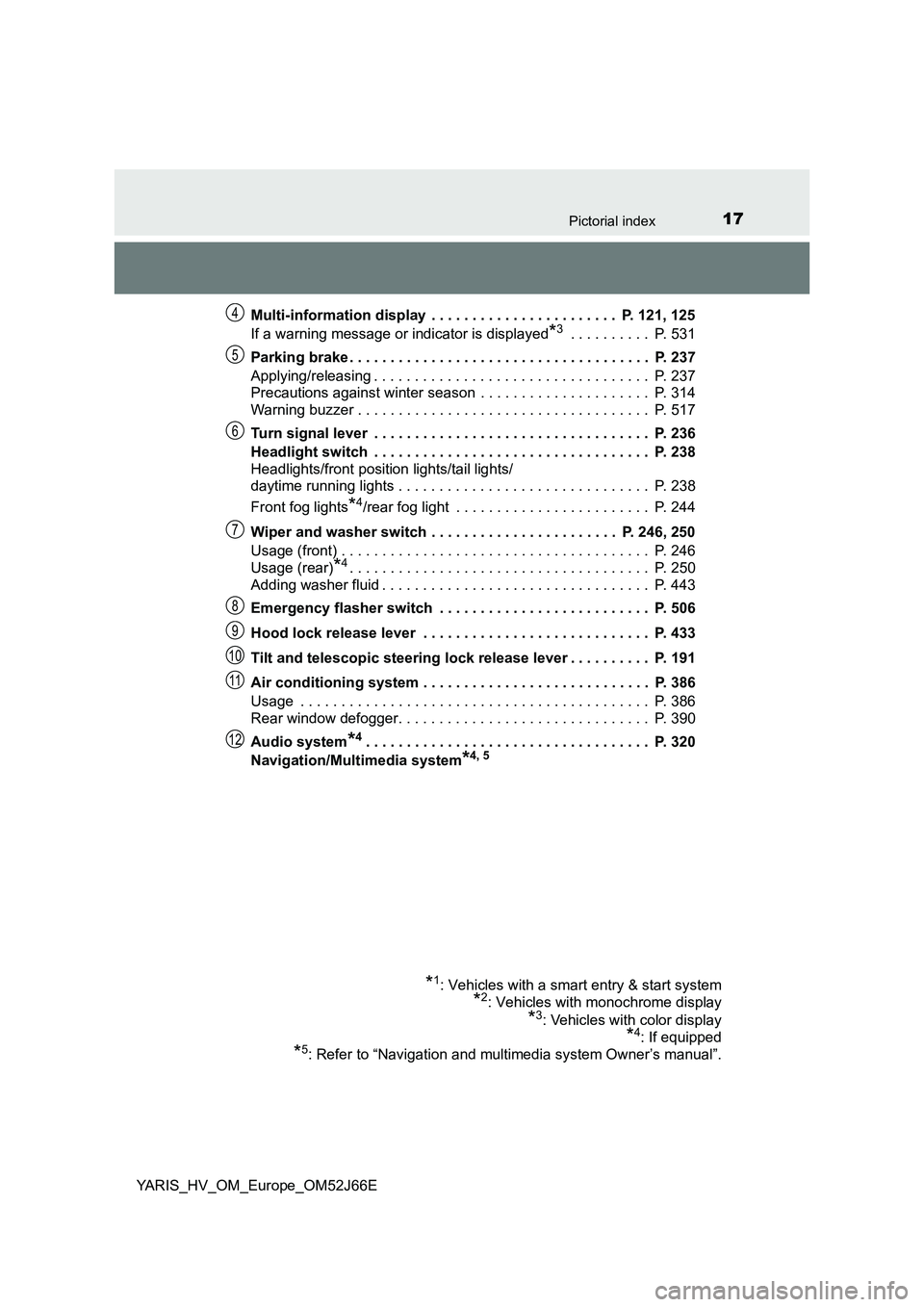
17Pictorial index
YARIS_HV_OM_Europe_OM52J66E
Multi-information display . . . . . . . . . . . . . . . . . . . . . . . P. 121, 125
If a warning message or indicator is displayed*3 . . . . . . . . . . P. 531
Parking brake . . . . . . . . . . . . . . . . . . . . . . . . . . . . . . . . . . . . . P. 237
Applying/releasing . . . . . . . . . . . . . . . . . . . . . . . . . . . . . . . . . . P. 237
Precautions against winter season . . . . . . . . . . . . . . . . . . . . . P. 314
Warning buzzer . . . . . . . . . . . . . . . . . . . . . . . . . . . . . . . . . . . . P. 517
Turn signal lever . . . . . . . . . . . . . . . . . . . . . . . . . . . . . . . . . . P. 236
Headlight switch . . . . . . . . . . . . . . . . . . . . . . . . . . . . . . . . . . P. 238
Headlights/front position lights/tail lights/
daytime running lights . . . . . . . . . . . . . . . . . . . . . . . . . . . . . . . P. 238
Front fog lights*4/rear fog light . . . . . . . . . . . . . . . . . . . . . . . . P. 244
Wiper and washer switch . . . . . . . . . . . . . . . . . . . . . . . P. 246, 250
Usage (front) . . . . . . . . . . . . . . . . . . . . . . . . . . . . . . . . . . . . . . P. 246
Usage (rear)*4. . . . . . . . . . . . . . . . . . . . . . . . . . . . . . . . . . . . . P. 250
Adding washer fluid . . . . . . . . . . . . . . . . . . . . . . . . . . . . . . . . . P. 443
Emergency flasher switch . . . . . . . . . . . . . . . . . . . . . . . . . . P. 506
Hood lock release lever . . . . . . . . . . . . . . . . . . . . . . . . . . . . P. 433
Tilt and telescopic steering lock release lever . . . . . . . . . . P. 191
Air conditioning system . . . . . . . . . . . . . . . . . . . . . . . . . . . . P. 386
Usage . . . . . . . . . . . . . . . . . . . . . . . . . . . . . . . . . . . . . . . . . . . P. 386
Rear window defogger. . . . . . . . . . . . . . . . . . . . . . . . . . . . . . . P. 390
Audio system*4. . . . . . . . . . . . . . . . . . . . . . . . . . . . . . . . . . . P. 320
Navigation/Multimedia system*4, 5
*1: Vehicles with a smart entry & start system
*2: Vehicles with monochrome display
*3: Vehicles with color display
*4: If equipped
*5: Refer to “Navigation and multimedia system Owner’s manual”.
4
5
6
7
8
9
10
11
12
Page 24 of 632
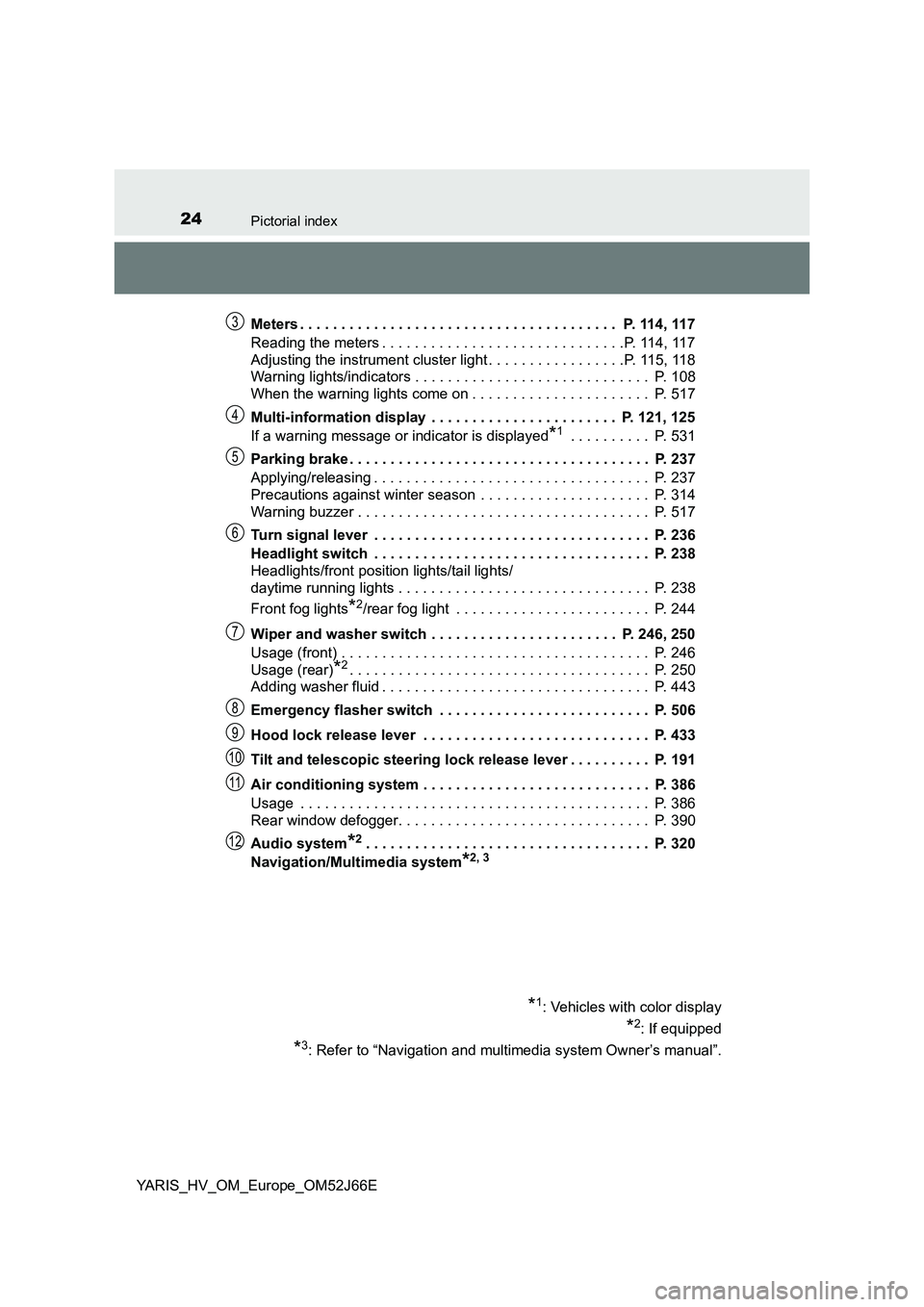
24Pictorial index
YARIS_HV_OM_Europe_OM52J66E
Meters . . . . . . . . . . . . . . . . . . . . . . . . . . . . . . . . . . . . . . . P. 114, 117
Reading the meters . . . . . . . . . . . . . . . . . . . . . . . . . . . . . .P. 114, 117
Adjusting the instrument cluster light . . . . . . . . . . . . . . . . .P. 115, 118
Warning lights/indicators . . . . . . . . . . . . . . . . . . . . . . . . . . . . . P. 108
When the warning lights come on . . . . . . . . . . . . . . . . . . . . . . P. 517
Multi-information display . . . . . . . . . . . . . . . . . . . . . . . P. 121, 125
If a warning message or indicator is displayed*1 . . . . . . . . . . P. 531
Parking brake . . . . . . . . . . . . . . . . . . . . . . . . . . . . . . . . . . . . . P. 237
Applying/releasing . . . . . . . . . . . . . . . . . . . . . . . . . . . . . . . . . . P. 237
Precautions against winter season . . . . . . . . . . . . . . . . . . . . . P. 314
Warning buzzer . . . . . . . . . . . . . . . . . . . . . . . . . . . . . . . . . . . . P. 517
Turn signal lever . . . . . . . . . . . . . . . . . . . . . . . . . . . . . . . . . . P. 236
Headlight switch . . . . . . . . . . . . . . . . . . . . . . . . . . . . . . . . . . P. 238
Headlights/front position lights/tail lights/
daytime running lights . . . . . . . . . . . . . . . . . . . . . . . . . . . . . . . P. 238
Front fog lights*2/rear fog light . . . . . . . . . . . . . . . . . . . . . . . . P. 244
Wiper and washer switch . . . . . . . . . . . . . . . . . . . . . . . P. 246, 250
Usage (front) . . . . . . . . . . . . . . . . . . . . . . . . . . . . . . . . . . . . . . P. 246
Usage (rear)*2. . . . . . . . . . . . . . . . . . . . . . . . . . . . . . . . . . . . . P. 250
Adding washer fluid . . . . . . . . . . . . . . . . . . . . . . . . . . . . . . . . . P. 443
Emergency flasher switch . . . . . . . . . . . . . . . . . . . . . . . . . . P. 506
Hood lock release lever . . . . . . . . . . . . . . . . . . . . . . . . . . . . P. 433
Tilt and telescopic steering lock release lever . . . . . . . . . . P. 191
Air conditioning system . . . . . . . . . . . . . . . . . . . . . . . . . . . . P. 386
Usage . . . . . . . . . . . . . . . . . . . . . . . . . . . . . . . . . . . . . . . . . . . P. 386
Rear window defogger. . . . . . . . . . . . . . . . . . . . . . . . . . . . . . . P. 390
Audio system*2. . . . . . . . . . . . . . . . . . . . . . . . . . . . . . . . . . . P. 320
Navigation/Multimedia system*2, 3
*1: Vehicles with color display
*2: If equipped
*3: Refer to “Navigation and multimedia system Owner’s manual”.
3
4
5
6
7
8
9
10
11
12
Page 50 of 632

501-1. For safe use
YARIS_HV_OM_Europe_OM52J66E
■If the SRS airbags deploy (inflate)
● Slight abrasions, burns, bruising, etc., may be sustained from SRS airbags,
due to the extremely high speed deployment (inflation) by hot gases.
● A loud noise and white powder will be emitted.
● Vehicles without SRS curtain shield airbags: Parts of the airbag module
(steering wheel hub, airbag cover and inflator) as well as the front seats may
be hot for several minutes. The airbag itself may also be hot.
● Vehicles with SRS curtain shield airbags: Parts of the airbag module (steer-
ing wheel hub, airbag cover and inflator) as well as the front seats, parts of
the front and rear pillars, and roof side rails, may be hot for several minutes.
The airbag itself may also be hot.
● The windshield may crack.
■ SRS airbag deployment conditions (SRS front airbags)
● The SRS front airbags will deploy in the event of an impact that exceeds the
set threshold level (the level of force corresponding to an approximately
20 - 30 km/h [12 - 18 mph] frontal collision with a fixed wall that does not
move or deform).
However, this threshold velocity will be considerably higher in the following
situations:
• If the vehicle strikes an object, such as a parked vehicle or sign pole,
which can move or deform on impact
• If the vehicle is involved in an underride collision, such as a collision in
which the front of the vehicle “underrides”, or goes under, the bed of a
truck
● Depending on the type of collision, it is possible that only the seat belt pre-
tensioners will activate.
Page 51 of 632
![TOYOTA YARIS 2018 Owners Manual 511-1. For safe use
1
For safety and security
YARIS_HV_OM_Europe_OM52J66E
■ SRS airbag deployment conditions (SRS side airbags and SRS curtain
shield airbags [if equipped])
● The SRS side airba TOYOTA YARIS 2018 Owners Manual 511-1. For safe use
1
For safety and security
YARIS_HV_OM_Europe_OM52J66E
■ SRS airbag deployment conditions (SRS side airbags and SRS curtain
shield airbags [if equipped])
● The SRS side airba](/manual-img/14/49201/w960_49201-50.png)
511-1. For safe use
1
For safety and security
YARIS_HV_OM_Europe_OM52J66E
■ SRS airbag deployment conditions (SRS side airbags and SRS curtain
shield airbags [if equipped])
● The SRS side airbags and SRS curtain shield airbags will deploy in the
event of an impact that exceeds the set threshold level (the level of force
corresponding to the impact force produced by an approximately 1500 kg
[3300 lb.] vehicle colliding with the vehicle cabin from a direction perpendic-
ular to the vehicle orientation at an approximate speed of 20 - 30 km/h
[12 - 18 mph]).
● The SRS curtain shield airbags may also deploy in the event of a severe
frontal collision.
■ Conditions under which the SRS airbags may deploy (inflate), other than
a collision
The SRS front airbags and SRS curtain shield airbags (if equipped) may also
deploy if a serious impact occurs to the underside of your vehicle. Some
examples are shown in the illustration.
■ Types of collisions that may not deploy the SRS airbags (SRS front air-
bags)
The SRS front airbags do not generally infl ate if the vehicle is involved in a
side or rear collision, if it rolls over, or if it is involved in a low-speed frontal
collision. But, whenever a collision of any type causes sufficient forward
deceleration of the vehicle, deployment of the SRS front airbags may occur.
● Hitting a curb, edge of pavement or hard
surface
● Falling into or jumping over a deep hole
● Landing hard or falling
● Collision from the side
● Collision from the rear
● Vehicle rollover
Page 88 of 632
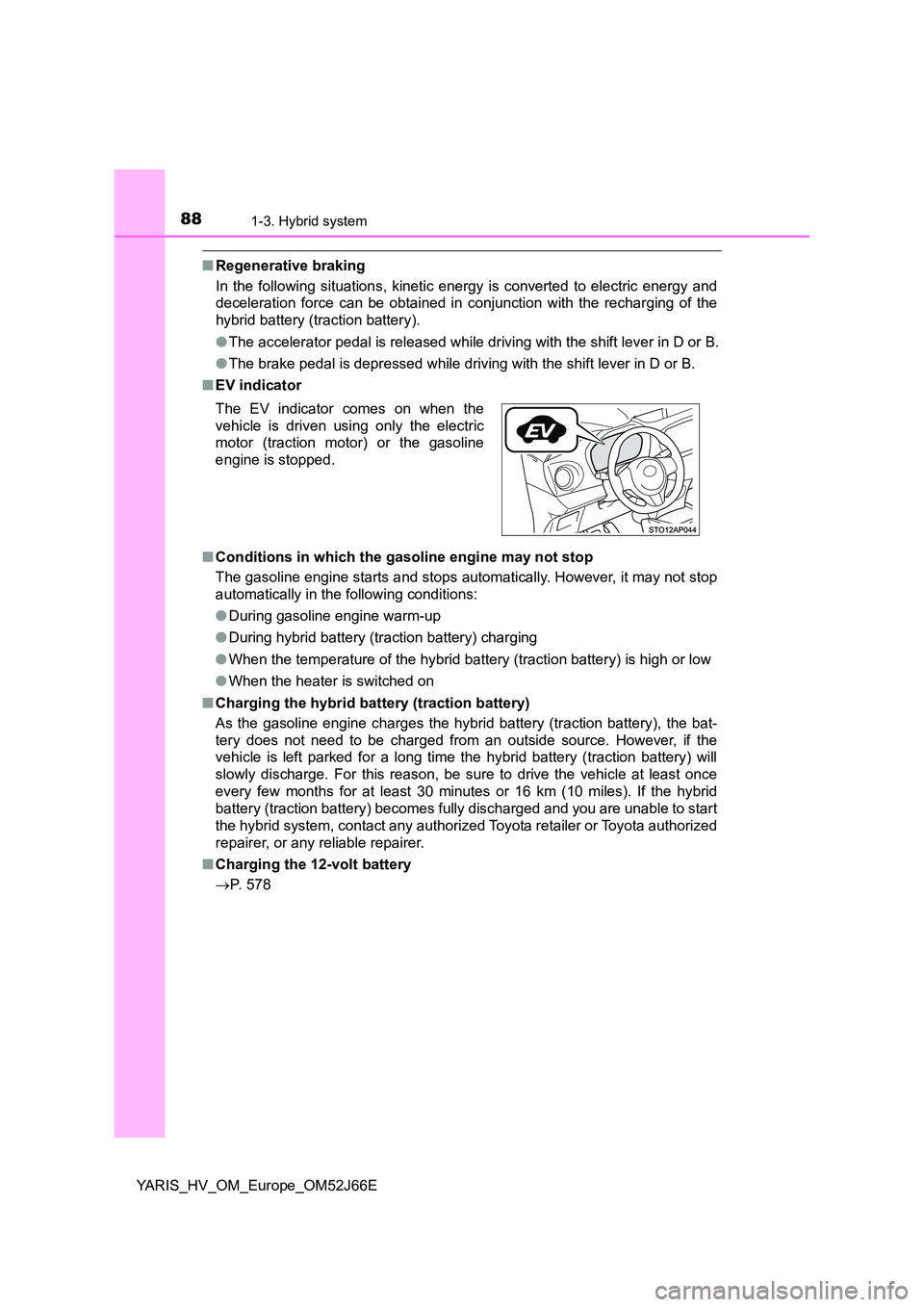
881-3. Hybrid system
YARIS_HV_OM_Europe_OM52J66E
■Regenerative braking
In the following situations, kinetic ener gy is converted to electric energy and
deceleration force can be obtained in c onjunction with the recharging of the
hybrid battery (traction battery).
● The accelerator pedal is released while driving with the shift lever in D or B.
● The brake pedal is depressed while driving with the shift lever in D or B.
■ EV indicator
■ Conditions in which the gasoline engine may not stop
The gasoline engine starts and stops automatically. However, it may not stop
automatically in the following conditions:
● During gasoline engine warm-up
● During hybrid battery (traction battery) charging
● When the temperature of the hybrid battery (traction battery) is high or low
● When the heater is switched on
■ Charging the hybrid battery (traction battery)
As the gasoline engine charges the hybrid battery (traction battery), the bat-
tery does not need to be charged from an outside source. However, if the
vehicle is left parked for a long time the hybrid battery (traction battery) will
slowly discharge. For this reason, be sure to drive the vehicle at least once
every few months for at least 30 minutes or 16 km (10 miles). If the hybrid
battery (traction battery) becomes fully discharged and you are unable to start
the hybrid system, contact any authorized Toyota retailer or Toyota authorized
repairer, or any reliable repairer.
■ Charging the 12-volt battery
P. 578
The EV indicator comes on when the
vehicle is driven using only the electric
motor (traction motor) or the gasoline
engine is stopped.
Page 90 of 632
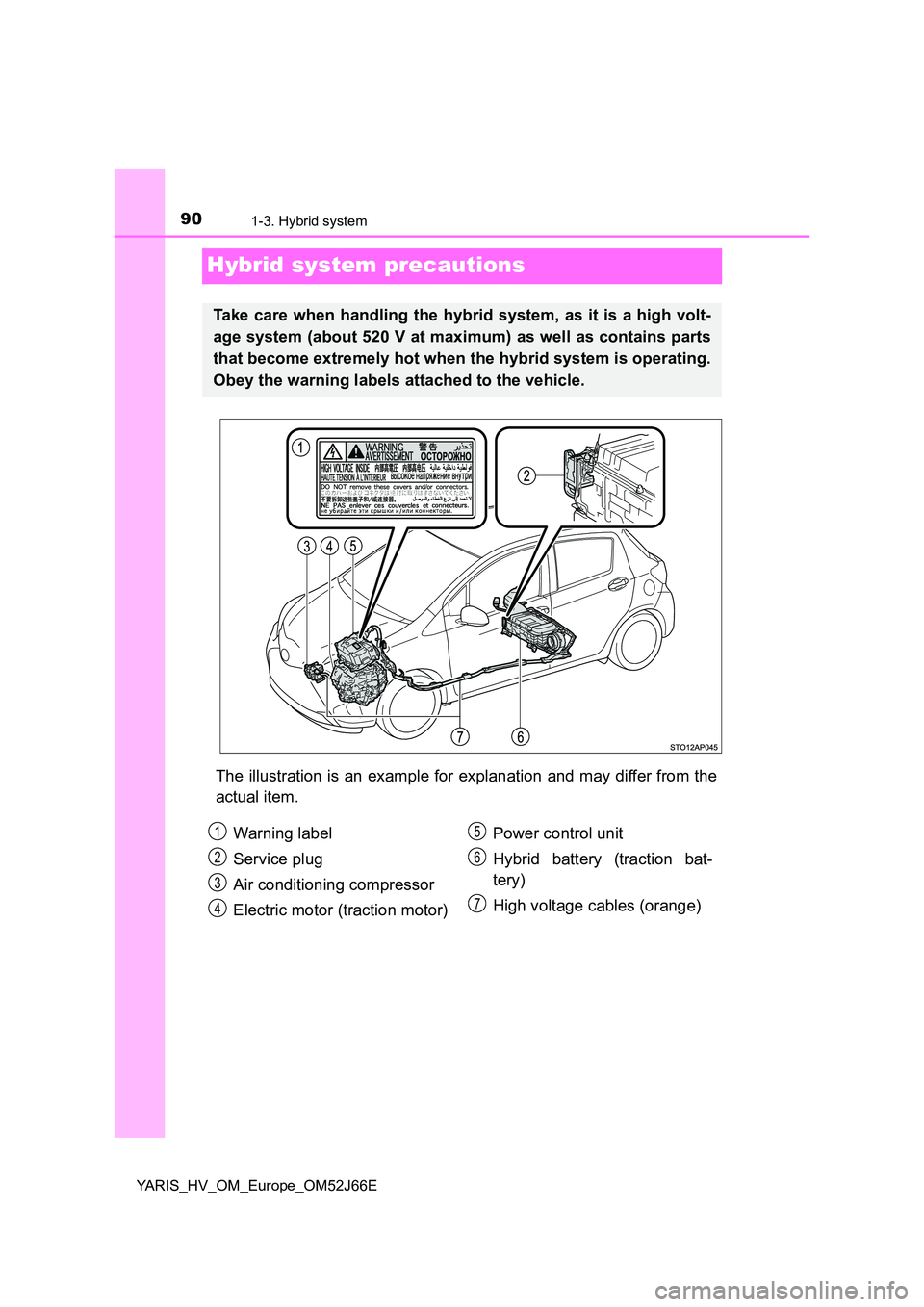
901-3. Hybrid system
YARIS_HV_OM_Europe_OM52J66E
Hybrid system precautions
The illustration is an example for explanation and may differ from the
actual item.
Take care when handling the hybrid system, as it is a high volt-
age system (about 520 V at maximum) as well as contains parts
that become extremely hot when the hybrid system is operating.
Obey the warning labels attached to the vehicle.
Warning label
Service plug
Air conditioning compressor
Electric motor (traction motor)
Power control unit
Hybrid battery (traction bat-
tery)
High voltage cables (orange)
1
2
3
4
5
6
7
Page 92 of 632
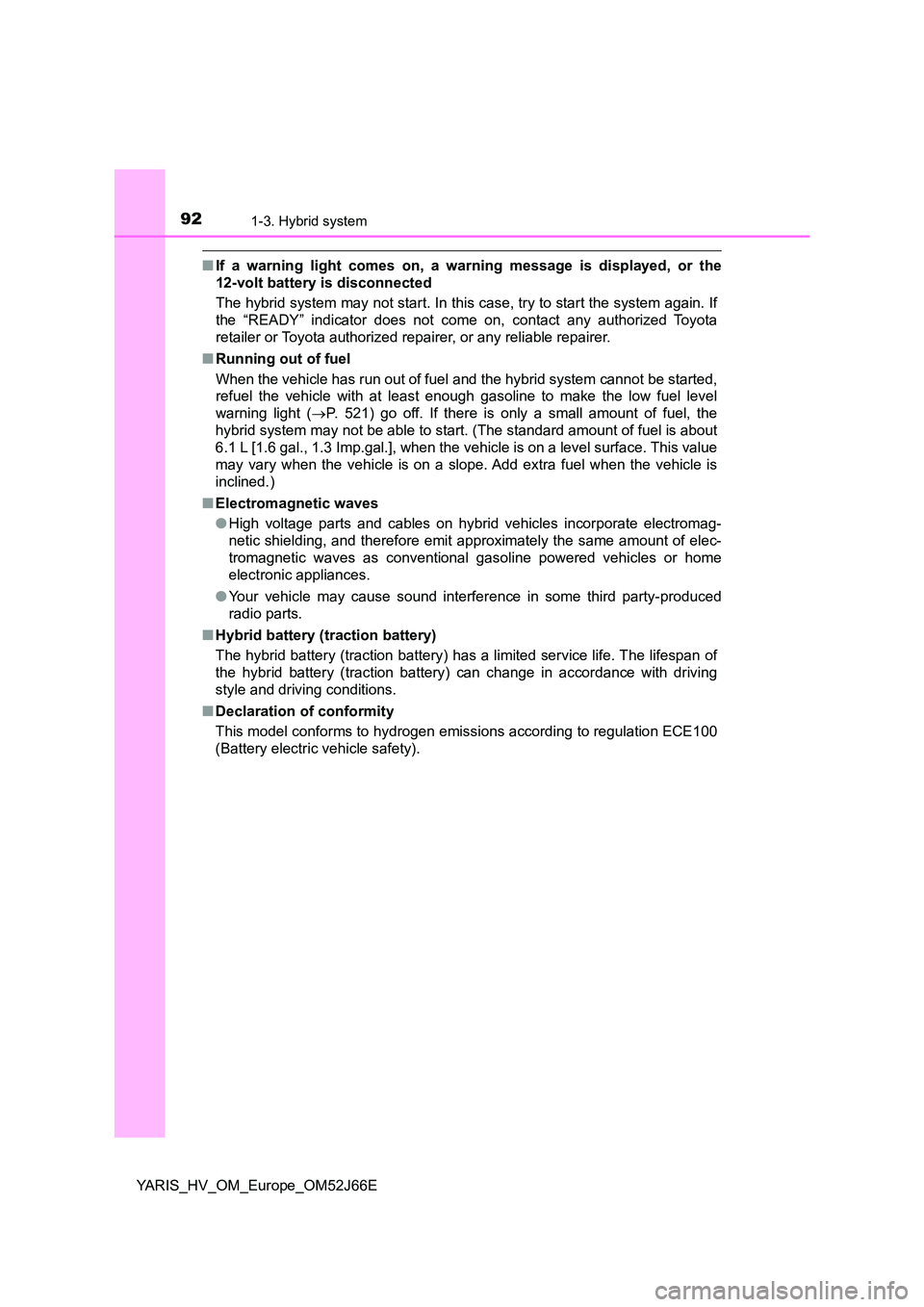
921-3. Hybrid system
YARIS_HV_OM_Europe_OM52J66E
■If a warning light comes on, a warning message is displayed, or the
12-volt battery is disconnected
The hybrid system may not start. In this case, try to start the system again. If
the “READY” indicator does not come on, contact any authorized Toyota
retailer or Toyota authorized repairer, or any reliable repairer.
■ Running out of fuel
When the vehicle has run out of fuel and the hybrid system cannot be started,
refuel the vehicle with at least enough gasoline to make the low fuel level
warning light ( P. 521) go off. If there is only a small amount of fuel, the
hybrid system may not be able to start. (The standard amount of fuel is about
6.1 L [1.6 gal., 1.3 Imp.gal.], when the vehicle is on a level surface. This value
may vary when the vehicle is on a slope. Add extra fuel when the vehicle is
inclined.)
■ Electromagnetic waves
● High voltage parts and cables on hybrid vehicles incorporate electromag-
netic shielding, and therefore emit approximately the same amount of elec-
tromagnetic waves as conventional gasoline powered vehicles or home
electronic appliances.
● Your vehicle may cause sound interference in some third party-produced
radio parts.
■ Hybrid battery (traction battery)
The hybrid battery (traction battery) has a limited service life. The lifespan of
the hybrid battery (traction battery) can change in accordance with driving
style and driving conditions.
■ Declaration of conformity
This model conforms to hydrogen emissions according to regulation ECE100
(Battery electric vehicle safety).